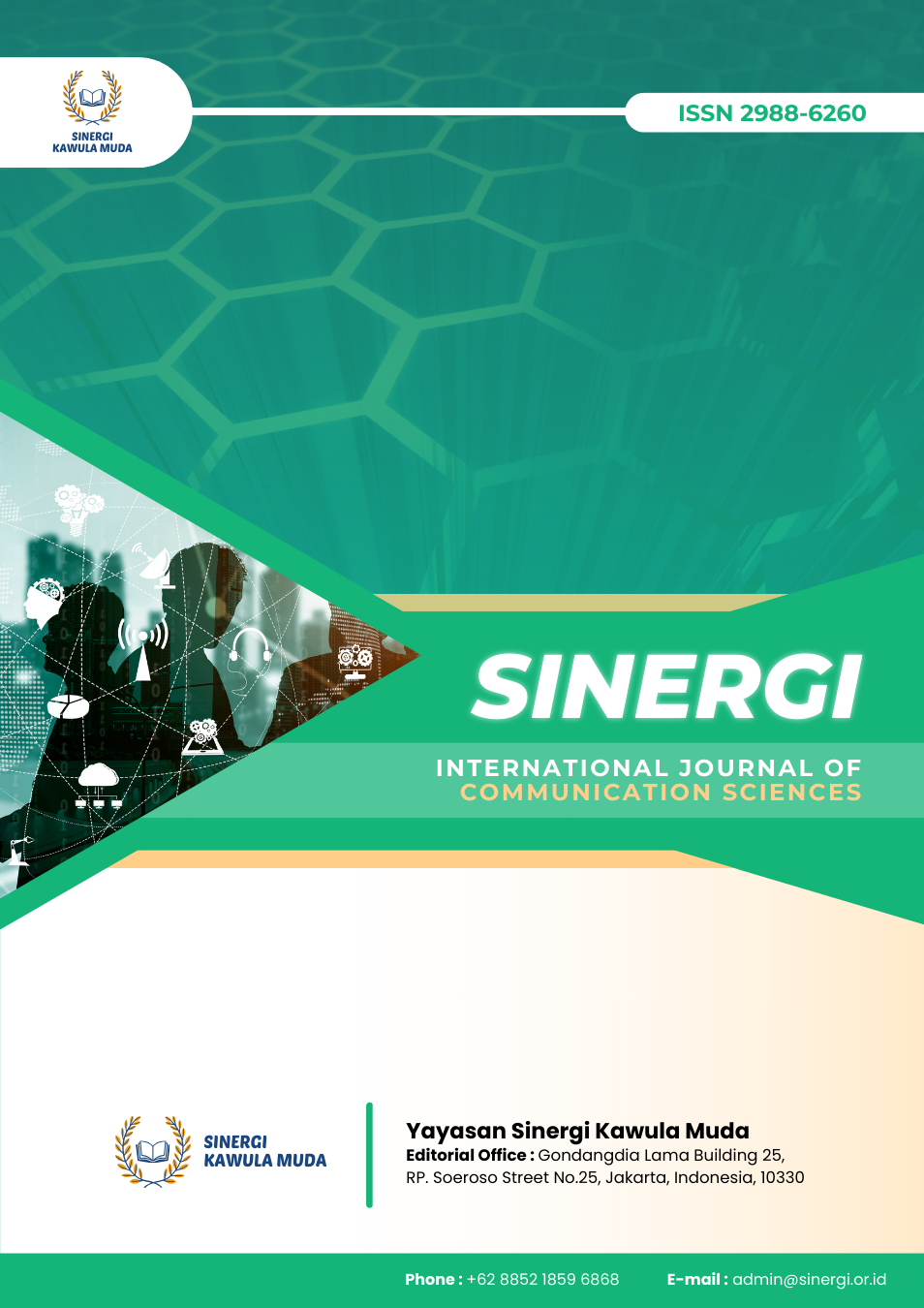Media, Gender, and Identity: Challenges and Strategies for Equitable Representation
DOI:
https://doi.org/10.61194/ijcs.v3i2.652Keywords:
gender representation, digital media, intersectionality, influencer culture, media literacy, narrative review, stereotypesAbstract
This narrative review explores the current state of gender representation across traditional and digital media platforms. The study aims to synthesize existing literature to understand how gender roles are portrayed, how structural systems influence representation, and what strategies can mitigate disparities. Employing a narrative method, this review analyzed peer-reviewed articles and grey literature sourced from Scopus, Web of Science, and Google Scholar, using a combination of Boolean search strategies to ensure a comprehensive dataset. Findings show that traditional media continues to depict women in stereotypical roles, while non-binary identities remain underrepresented or mischaracterized. In digital media, influencers reinforce aspirational gender norms, yet also create opportunities for visibility and activism. Intersectional research reveals that individuals with overlapping marginalized identities face compounded misrepresentation. Structural barriers—such as media ownership, editorial bias, and algorithmic filtering—sustain these portrayals. Comparative studies underscore the influence of national policy and cultural context on gender narratives. This study concludes that integrated interventions are essential to promoting authentic and diverse gender representations. Media literacy education, inclusive regulatory frameworks, and algorithmic reforms are key to disrupting entrenched inequalities. Further research should focus on longitudinal impacts and explore culturally specific media contexts to enrich global understanding.
References
Asenbaum, H. (2023). The politics of becoming. https://doi.org/10.1093/oso/9780192858870.001.0001 DOI: https://doi.org/10.1093/oso/9780192858870.001.0001
Bailey, J., Steeves, V., Burkell, J., & Regan, P. (2013). Negotiating with gender stereotypes on social networking sites. Journal of Communication Inquiry, 37(2), 91-112. https://doi.org/10.1177/0196859912473777 DOI: https://doi.org/10.1177/0196859912473777
Banerjee, R., & Mitra, S. (2024). Reconstituting the ‘good woman’: Gendered visual politics on social media during 2021 state election in West Bengal, India. Convergence: The International Journal of Research Into New Media Technologies. https://doi.org/10.1177/13548565241287588 DOI: https://doi.org/10.1177/13548565241287588
Bauer, N., & Taylor, T. (2022). Selling them short? Differences in news coverage of female and male candidate qualifications. Political Research Quarterly, 76(1), 308-322. https://doi.org/10.1177/10659129221086024 DOI: https://doi.org/10.1177/10659129221086024
Biswal, S. (2019). Disability, deficiency, and excess: A cinematic construction of disability in popular Odia cinema. Media Watch, 10(3). https://doi.org/10.15655/mw/2019/v10i3/49685 DOI: https://doi.org/10.15655/mw/2019/v10i3/49685
Blanco-Gómez, M., & Ortiz, M. (2024). An analysis of linguistic resources for sports tourism media discourse: A case study of the Women’s World Cup final in Sydney. Revista Alicantina De Estudios Ingleses, (41), 239-260. https://doi.org/10.14198/raei.2024.41.11 DOI: https://doi.org/10.14198/raei.2024.41.11
Brún, A., McCarthy, M., McKenzie, K., & McGloin, A. (2013). “Fat is your fault”. Gatekeepers to health, attributions of responsibility and the portrayal of gender in the Irish media representation of obesity. Appetite, 62, 17-26. https://doi.org/10.1016/j.appet.2012.11.005 DOI: https://doi.org/10.1016/j.appet.2012.11.005
Butkowski, C. (2020). Beyond “commercial realism”: Extending Goffman’s gender display framework to networked media contexts. Communication Culture and Critique, 14(1), 89-108. https://doi.org/10.1093/ccc/tcaa026 DOI: https://doi.org/10.1093/ccc/tcaa026
Calvo-Calvo, M. (2014). Sexist stereotypes and biases associated with the female nursing model in advertising communication. Texto & Contexto - Enfermagem, 23(3), 530-537. https://doi.org/10.1590/0104-07072014004120012 DOI: https://doi.org/10.1590/0104-07072014004120012
Cardo, V. (2020). Gender politics online? Political women and social media at election time in the United Kingdom, the United States and New Zealand. European Journal of Communication, 36(1), 38-52. https://doi.org/10.1177/0267323120968962 DOI: https://doi.org/10.1177/0267323120968962
Condeza, R., Matus, P., & Vergara, E. (2021). Stereotypes and sexualization of girls and adolescent girls in Chilean advertising: A case study. Tripodos, (50), 187-204. https://doi.org/10.51698/tripodos.2021.50p187-204 DOI: https://doi.org/10.51698/tripodos.2021.50p187-204
Corsbie‐Massay, C., & Wheatly, M. (2022). The role of media professionals in perpetuating and disrupting stereotypes of women in STEM fields. Frontiers in Communication, 7. https://doi.org/10.3389/fcomm.2022.1027502 DOI: https://doi.org/10.3389/fcomm.2022.1027502
Creedon, P. (2014). Women, social media, and sport. Television & New Media, 15(8), 711-716. https://doi.org/10.1177/1527476414530476 DOI: https://doi.org/10.1177/1527476414530476
Cukier, W., Jackson, S., & Gagnon, S. (2019). The representation of women and racialized minorities as expert sources on-air in Canadian public affairs television. Canadian Journal of Communication, 44(1), 25-47. https://doi.org/10.22230/cjc.2019v44n1a3321 DOI: https://doi.org/10.22230/cjc.2019v44n1a3321
Dalyot, K., Rozenblum, Y., & Baram‐Tsabari, A. (2022). Engagement patterns with female and male scientists on Facebook. Public Understanding of Science, 31(7), 867-884. https://doi.org/10.1177/09636625221092696 DOI: https://doi.org/10.1177/09636625221092696
Denham, B. (2020). Media representations as a form of stacking: Male and female athletes featured on men’s magazine covers, 1980–2019. Communication & Sport, 10(1), 30-51. https://doi.org/10.1177/2167479520927993 DOI: https://doi.org/10.1177/2167479520927993
Elier, A., Raihanah, M., & Hashim, R. (2023). Flipping tropes & subverting stereotype priming in the Hunger Games trilogy. Jurnal Komunikasi Malaysian Journal of Communication, 39(1), 353-371. https://doi.org/10.17576/jkmjc-2023-3901-20 DOI: https://doi.org/10.17576/JKMJC-2023-3901-20
Gitler, I., & Lachover, E. (2021). Gendered memory and miniaturization in graphic design: Representations of women on Israeli postage stamps. Design Issues, 37(3), 18-32. https://doi.org/10.1162/desi_a_00645 DOI: https://doi.org/10.1162/desi_a_00645
Hildebrand, J., & Sheller, M. (2018). Media ecologies of autonomous automobility. Transfers, 8(1), 64-85. https://doi.org/10.3167/trans.2018.080106 DOI: https://doi.org/10.3167/TRANS.2018.080106
Hindes, S., & Fileborn, B. (2020). Reporting on sexual violence ‘inside the closet’: Masculinity, homosexuality and #MeToo. Crime Media Culture, 17(2), 163-184. https://doi.org/10.1177/1741659020909872 DOI: https://doi.org/10.1177/1741659020909872
Jaramillo-Dent, D., Pulido, P., & Rodríguez, M. (2021). Right-wing immigration narratives in Spain: A study of persuasion on Instagram Stories. European Journal of Communication, 37(2), 161-180. https://doi.org/10.1177/02673231211012157 DOI: https://doi.org/10.1177/02673231211012157
Jester, N., & Walters, R. (2024). Gender washing war: Arms manufacturers and the hijacking of #InternationalWomensDay. International Political Sociology, 18(3). https://doi.org/10.1093/ips/olae021 DOI: https://doi.org/10.1093/ips/olae021
Johnstonbaugh, M. (2018). Where are all of the women? Untangling the effects of representation, participation, and preferences on gender differences in political press coverage. Socius: Sociological Research for a Dynamic World, 4. https://doi.org/10.1177/2378023118793738 DOI: https://doi.org/10.1177/2378023118793738
Downloads
Published
Issue
Section
License
Copyright (c) 2025 Putri Ayu Lestari, Hagar Yehia Abd Elfattah

This work is licensed under a Creative Commons Attribution 4.0 International License.





